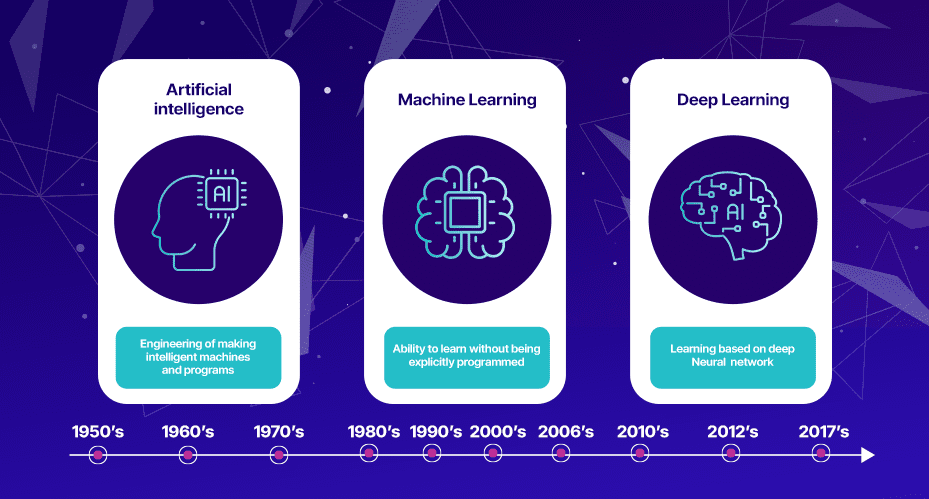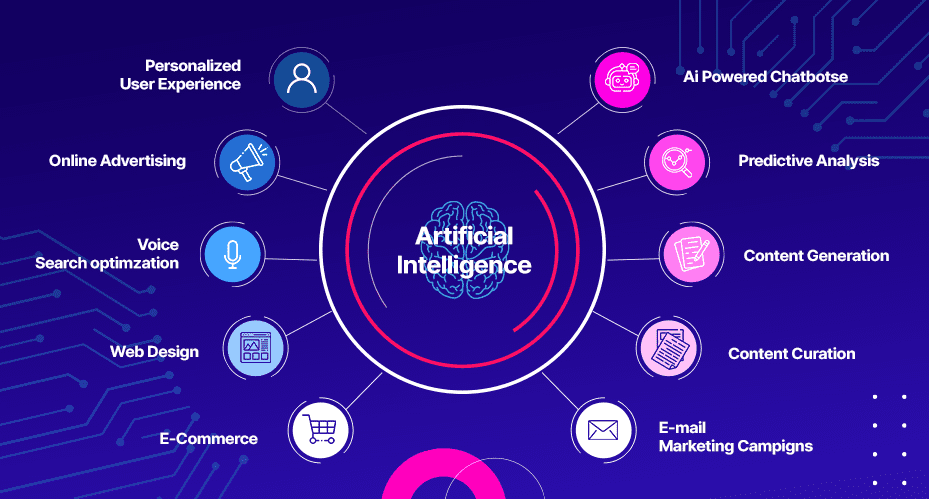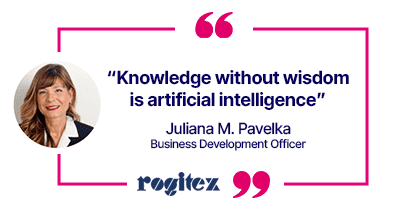According to a study by Accenture in 2021, only 12% of companies use AI to boost their growth and results. 30% of their revenue would be attributable to artificial intelligence. At the same time, these companies stand out in terms of customer experience and sustainability while growing up to 50% faster than their peers.
Eminence takes a look at what artificial intelligence is, what it can be used for, and how it can impact your marketing strategy. We will also present the best tools to use to increase your productivity.
What is Artificial Intelligence?
How to define Artificial Intelligence?
Artificial Intelligence (AI) is a branch of computer science that deals with the design of computer systems capable of intelligent behavior.
AI relies on machine learning, voice and image recognition, natural language understanding, and other technologies to simulate human intelligence. Its goal? To perform tasks that normally require human intervention. In other words, to think and act like us.
Where does artificial intelligence come from?
The beginnings of artificial intelligence date back to 1943, when scientists Warren McCullough and Walter Pitts published the article “A Logical Calculus of Ideas Immanent in Nervous Activity”, in which they introduced the first mathematical model for creating a neural network.
Four years later, students Marvin Minsky and Dean Edmonds created the first neural network computer, named Snarc. That year, Alan Turing, a cryptologist, published the Turing Test, which is still used today to evaluate AIs.
In 1952, Arthur Samuel invented a software capable of learning to play chess independently.
The term and notion of “artificial intelligence” were truly born in 1956 during the Dartmouth Summer Research Project on Artificial Intelligence conference by John McCarthy.
For decades, technology has been constantly evolving and has now spread to many areas we encounter every day.
How does artificial intelligence work?
Artificial intelligence is the result of a multidisciplinary approach:
- electronics: data collection, neural networks,
- computer science: data processing, deep learning,
- mathematics: data analysis models.
AI relies on a technology based on sets of algorithms, allowing devices and software to be equipped with analysis and decision-making capabilities. Thanks to the data already assimilated (machine learning and deep learning), it can adapt to different requests and situations by making predictions.
Artificial intelligence is based on 3 pillars: intentionality, intelligence, and adaptability.
AI has grown by 15.2% in 2021 and is now more than ever a flagship sector of IT. It has profoundly impacted how work is organized and human-machine interactions and is now the reason why multiple software and applications are being developed.

GPT-3 is the most significant language model in artificial intelligence and is widely praised. Developed by the American company OpenAI, GPT-3 had no less than 175 billion parameters at its launch in 2020!
Its successor, GPT-4, is expected to be released in the next few months, provided that it works optimally to limit security and quality risks.
How can it be used?
One of the major interests of AI is that it can be applied to all types of industries, among which we could mention:
- AI in Healthcare: development of personalized treatments and new drugs, medical image analysis, virtual assistants, etc.
- Retail: product recommendations, personalized advertisements, product layout (picking), inventory management, etc.
- Factories: predictive production, preventive maintenance, etc.
- Banks: fraud prevention and detection, customer solvency, data management, etc.
- Automotive: automatic driving, detection, etc.
- E-commerce: chatbox voice assistance, inventory optimization, dynamic pricing, customer segmentation, pathways, etc.
The impact of artificial intelligence on marketing
Companies have become aware of the valuable assistance provided by AI and are increasingly using it in their operations and activities.
In marketing, artificial intelligence can speed up and improve marketing processes, while reducing operating and training costs.

Content personalization: AI can help companies tailor their marketing strategy to the interests and behaviors of their target audience.
Using data on users’ browsing habits and preferences, AI tools can personalize offers and landing pages to maximize conversion rates, while improving the user experience.
Time optimization: AI can automate tasks such as keyword research, headline generation, and content production, which can free up time for more strategic thinking or creative activities.
Data Analytics Performance: AI can help companies understand trends and make more informed decisions by quickly and thoroughly analyzing large amounts of data.
Customer relationship: chatbots can manage real-time interactions with customers and help them resolve their issues quickly.
Top AI tools to increase performance
Here is a short list of AI solutions, tools, and software to improve your marketing performance and save time on repetitive tasks:
AI for SEO and copywriting
Keyword optimization: Google Ads and SEMrush use AI to optimize keyword strategies and maximize advertising visibility and relevance.
Copywriting: various automated content generators and semantic analysis tools exist and can generate SEO-optimized articles and editorial content in record time and, in principle, without mistakes!
There are many different tools, it’s up to you to choose the one that will be the most adapted to your needs and use:
- Chat GPT: the most famous tool that offers a free version. You can create texts, chatboxes, lines of code, emailing, and advertising campaigns
- Jasper: the most complete tool for writing any kind of content, including video scripts
- Copy: well-suited for short content, with a clear interface, it is less focused on long SEO content
- Blog Idea Generator: creates content from a given keyword. A “Give me a new idea” feature generates proposals until you get the one that suits you best.
- Copysmith: writes SEO-oriented articles for a blog, a landing page, metadata, ads, etc. Its special feature: it learns from your content changes and gets smarter and smarter!
- Headlime: generates content, and titles, but leaves room for personal creation. It can continue writing a text with the “write for me” function if you find yourself stuck or out of inspiration.
- Writesonic: offers about twenty different contents in 20 languages. Its advantage? It offers you a dozen different versions following your brief: you just have to choose!
Do you require SEO-oriented writing?
→ Let’s discuss it together!
AI for social networks
In the field of social networks, AI facilitates content creation:
- Ocoya: facilitates the creation and scheduling of social media content.
- Predis: generates posts based on a single sentence describing your company and suggests ideas for posts, titles, or custom hashtags. It also suggests designs adapted to your company’s colors.
- Vidyo: condenses videos into shorter clips suitable for social networks.
- Whisper: creates text from audio, which is ideal for subtitling your videos.
- Cleanvoice: allows a perfect track for your videos and podcasts, thanks to the removal of interfering sounds, such as language problems like stuttering.
- Podcastle: guarantees studio quality sound when recording your podcasts, even from a simple computer.
AI in design and creation
Artificial intelligence is also very present in the field of design, graphics, and artistic creation:
Flair: to make product staging, as if they were from a photo shoot.
Patterned or Stockimg: to obtain royalty-free patterns and images
Illustroke: create vector images from a short description
Cleanup.picture: to erase a part of a picture (defects, objects, people, texts…)
Looka: to get ideas for brand names and logos.
Synthesia: ideal to create “humanized” videos of presentation, training with from text.
Beatoven: develops unique and royalty-free music.
Soundraw: able to generate ambient music.
AI in data
Web data analytics: Tools such as Google Analytics, Adobe Analytics, Tableau, and Power BI help analyze performance data and optimize advertising campaigns.
Sales forecasting: Solutions such as Salesforce Einstein and Oracle CX Cloud use machine learning to predict sales trends and adjust marketing strategies accordingly.
Trend detection: Solutions such as Google Trends and BrandWatch use AI to monitor online trends and inform marketing strategies accordingly.
Would you like to know how your website or campaigns are performing?
→ Let’s make an appointment to discuss your options.
AI in web development
For web development, AI can be used to automate testing and deployment processes.
Tools, such as Unbounce can be used to design landing pages, as well as emails.
AI technologies, such as Quickchat for chatbots, can help companies automate customer interactions and improve the user experience.
Other useful tools
As you can see, there are hundreds, if not thousands, of applications and tools designed to facilitate your team’s work.
To finish, here are a few more tools to simplify your organization.
- Otter.ai: able to generate written reports, such as those of your meetings, from an audio recording in person or remotely (Meet, Zoom, Teams). The little extra? It can even synthesize them for you!
- Puzzle: generates glossaries (definitions, key concepts) according to the content, which can be very useful in the context of very technical articles for example.
- Krisp: erases background voices, noise, and echoes during your calls.
The benefits and limits of artificial intelligence
Benefits and advantages of AI
The advantages of artificial intelligence are undeniable and multiple:
- Time-saving: AI can work 24/7, 365 days a year. It is tireless.
- Money saving: repetitive tasks with little added value can be delegated to it to increase its productivity
- A source of information: continuous, universal, heterogeneous, allowing to approach different axes
- Data exploitation: extraordinary processing capacities
- Versatile use: vast areas of expertise, from the simplest to the most complex
The limitations of AI
AI remains artificial as its name indicates and cannot fully replace humans (thankfully!).
- It does not know the subtleties of language, which can lead to texts and images that are sometimes totally bizarre!
- It requires indispensable control.
- It generates very homogeneous, theoretical, and general information, which is detrimental to the quality and diversity of the content disseminated.
- Its content remains cold and does not diffuse emotions, which limits brand communication.
- Without ethical control, AI can broadcast fake news and deep fakes, such as videos, if it learns false information.
.
The ethical aspect
Many computer scientists are warning that reverse engineering is needed to ensure that artificial intelligence is used ethically and responsibly.
For example, being able to trace and deconstruct the sometimes-simplistic reasoning of AI in the context of databases can prove to be discriminatory towards people with machine learning.
Currently, sociologists, anthropologists, and engineers (Stanford) are collaborating to create a legal framework, and an ethical guide is being developed to ensure a humane, humanistic, and secure AI.
In this article, we have focused on the marketing and digital aspects of artificial intelligence. However, the dangers associated with the use of AI are limitless. More than a hundred experts have called on the United Nations to ban “killer robots” and other autonomous military weapons.
In this innovation race led by the United States, China planned in 2018 a massive investment of 150 billion dollars by 2030 in AI technology, with the ambition of becoming the leader of this industry.
CONCLUSION
Although it is an undeniable asset for low value-added and automated tasks, AI must be used as an external help, and it implies control over the content it generates. In this sense, AI is not yet able to replace human logic skills, especially in terms of creativity and strategy.
“Because of its ability to learn and evolve autonomously, AI could one day surpass human intelligence. It could then decide to turn against its creators,” according to DataScientest.
Will reality meet fiction?

